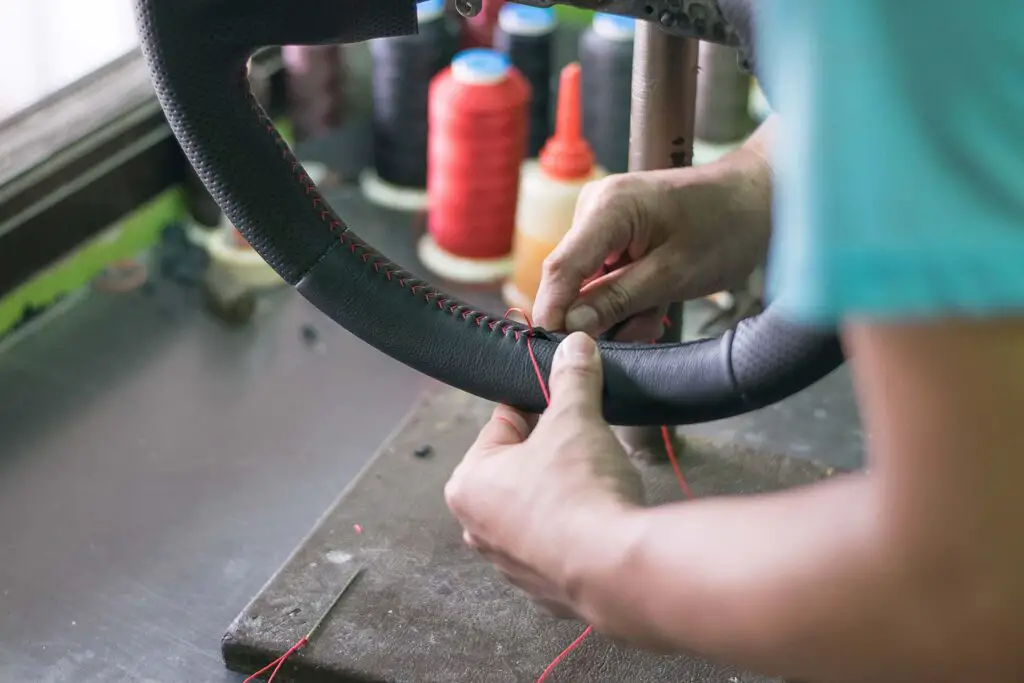Embark on a journey to transform your driving experience as we unravel the answer to a common question, “What size steering wheel cover do I need?” Navigating the diverse world of covers requires understanding dimensions, materials, and installation techniques. Discover the key factors that contribute to comfort, safety, and aesthetics, ensuring you make the perfect choice for your vehicle’s interior.
What Size Steering Wheel Cover Do I Need?
To determine the size of the cover you need, measure the diameter of your steering wheel using a flexible measuring tape or a string. Ensure the measurement is taken from one side to the other, passing through the center. Refer to our detailed guide for precise instructions, and choose an accessory that corresponds to your measured size for a snug and perfect fit.
The surge in customer desire to enhance the appearance of their vehicles is propelling the market forward. Wheel covers, resembling alloy wheels at a lower cost, are gaining popularity, especially among the growing demographic of younger consumers. The rise in demand for automobile accessories, coupled with the affordability of wheel covers, contributes significantly to their high demand.
Beyond aesthetics, these covers play a vital role in shielding vehicle wheels from dirt and corrosion, contributing to the overall maintenance of the vehicle’s condition and resale value. As of 2022, the Wheel Cover Market is valued at US$ 1.17 Bn. and is anticipated to grow at a rate of 8.7% from 2023 to 2029, projecting a market size of nearly US$ 1.49 Bn. by 2029.

Start With Understanding the Dimensions
Understanding the dimensions of this accessory is a crucial first step in enhancing your driving experience. The sizes vary across vehicles, and accurately measuring steering wheel diameter is essential to ensure a perfect fit for your chosen accessory. The diameter, measured from one side to the other, plays a significant role in determining the appropriate size.
Knowing the accurate size ensures that the accessory not only fits snugly but also enhances comfort and control. A steering wheel that matches your vehicle’s specifications contributes not only to aesthetic appeal but also to the overall safety and ease of handling while on the road.
Explore All the Tools and Techniques for Measuring Your Steering Wheel
Changing the vehicle interior accessories like these surely will require a systematic approach and the right tools. This being said, you’ll need the following tools:
- Measuring Tape – A flexible measuring tape is essential for determining the diameter of the wheel. It allows for precise measurements and is a standard tool for this purpose.
- String – In case a measuring tape is unavailable, a string can be used to mark the circumference of the steering wheel. This method provides an alternative way to measure the size accurately.
- Ruler – A ruler is necessary to measure the length of the string if you choose the alternative method with the string. It ensures that you obtain an accurate measurement for choosing the right size.
Begin by positioning the wheel in a way that allows easy access for measurement (it’s best to lock it, but ensure you remember to unlock it after the measuring). Take note of the diameter by measuring from one side to the other, passing through the center. Utilize a flexible measuring tape for accuracy.
Additionally, consider employing a string if a measuring tape is unavailable – mark the circumference and then measure the string against a ruler. To guarantee a thorough and precise measurement, it’s essential to have tools such as a measuring tape, string, and a ruler. Armed with these instruments and our detailed guide, you’ll confidently obtain the accurate measurements needed to choose the perfect accessory for your vehicle.

Steering Wheel Cover Size Guide – Types and Size Variations
These overs come in various materials such as leather, silicone, cloth, and more, each offering unique characteristics. Leather, known for its luxurious feel, provides a classic and sophisticated touch to your wheel. On the other hand, silicone covers are prized for their durability and resistance to wear and tear. Cloth covers, with their comfort and breathability, offer a more casual and cozy option.
It’s crucial to note that the choice of the best steering wheel cover material significantly impacts the size and fit of the cover. Some materials may be more pliable, allowing for a snug fit, while others might require specific sizing considerations. In the upcoming sections, we’ll explore how these material variations can influence the selection of the right size, ensuring a harmonious blend of style and functionality for your accessory.
Universal vs. Custom Steering Wheel Covers – What Is a Better Option for You?
When it comes to these interior accessories, the choice between custom-fit and universal options introduces a nuanced decision-making process. Custom-fit covers, tailored to the exact specifications of your vehicle’s wheel, offer a seamless and snug fit. This precision ensures a polished appearance and steering wheel grip enhancement. However, the downside lies in the potentially higher cost and limited availability for certain models.
On the other hand, universal covers boast versatility (you can even shrink it or expand it and make it a truck cover), fitting a range of sizes. While they are often more affordable and widely accessible, the trade-off may involve a less tailored appearance and a looser fit.
When making your decision, consider the size of your steering wheel as a crucial factor. For those seeking a tailored and specific fit, custom options are preferable. Meanwhile, if versatility and budget are priorities, universal covers may be the ideal choice. Striking the right balance between fit, style, and budget ensures an accessory that not only enhances aesthetics but also caters to your individual preferences and needs.

Steering Wheel Cover Installation Tips for a Perfect Fit
Achieving a perfect fit for your accessory involves a meticulous installation process. Begin by laying the protective accessory flat and ensuring it’s oriented correctly. Gradually work it onto the wheel, starting from the top and moving downwards. Apply even pressure, guiding the cover into place while ensuring it doesn’t twist or bunch up. Tuck any excess material neatly around the edges for a polished finish.
Check Out Some Common Pitfalls
One common mistake to avoid is rushing the installation – take your time to prevent wrinkles or uneven fits. Additionally, overlooking alignment can lead to an awkward appearance and compromised functionality. Be mindful of the cover’s seams, aligning them with the steering wheel’s features for a seamless look. Avoid pulling too hard on the cover, as this may distort its shape or strain the stitching. By following these detailed instructions and steering clear of common pitfalls, you’ll master the art of installation, ensuring your accessory achieves the perfect fit for both aesthetic appeal and functionality.
Adjusting Your Cover for Optimal Steering Wheel Comfort and Safety
Once your steering wheel cover is installed, fine-tuning its fit is key to achieving optimal grip and comfort. Start by adjusting the cover’s position to ensure it aligns precisely with the contours of your wheel. Smooth out any wrinkles or folds, paying special attention to the areas around the spokes. If your cover has lacing or adjustable features, use them to customize the fit further. Ensure that the cover sits securely on the wheel without any slippage, providing a comfortable and stable grip.
An essential aspect often overlooked is the importance of a secure fit for safety. A properly fitted accessory not only enhances driving comfort but also minimizes the risk of distraction or discomfort while on the road. Accessories that shift or loosen during use can compromise your control of the vehicle, making a secure fit crucial for a safe and enjoyable driving experience. By mastering these adjustment techniques, you’ll not only optimize the comfort of your accessory but also prioritize safety on the road.

Caring for Your Steering Wheel Cover – How to Maintain Your Accessories?
Ensuring the longevity and pristine appearance of your accessory involves adopting effective maintenance and cleaning practices. Different materials demand specific care, so start by identifying the material of your accessory. For leather covers, use a mild leather cleaner to gently remove dirt and maintain its suppleness. Silicone covers can be wiped down with a damp cloth to retain their durability and shine. Cloth covers may benefit from regular vacuuming and spot cleaning to preserve their freshness.
Proper maintenance not only safeguards the appearance but also contributes to the cover’s overall longevity. Regular cleaning prevents the buildup of grime and contaminants that can lead to premature wear and tear. By investing time in appropriate care, you extend the life of your accessories, ensuring it remains not only a stylish addition to your vehicle but also functional and durable steering wheel covers for miles to come.
When to Replace Your Interior Accessory?
Recognizing the signs that indicate it’s time to replace your accessory is essential in maintaining both comfort and safety. If you observe visible wear and tear, such as cracks, fraying, or fading, it’s a clear indication that the accessory has reached the end of its effective lifespan. Loss of elasticity or an uncomfortable texture during use may also signal the need for replacement.
Choosing the right time for this transition is crucial for ensuring continuous comfort and grip. Delaying replacement when the accessory has deteriorated can lead to discomfort, compromised grip, and even potential safety hazards. By proactively identifying these signs and replacing your accessory at the appropriate time, you not only maintain the aesthetic appeal of your vehicle’s interior but also prioritize a secure and enjoyable driving experience.

Steering Toward Your Ideal Drive
Whether choosing between custom-fit and universal options, adjusting for optimal comfort, or deciding when to replace your accessory, our blog offers insights to make informed decisions. Remember, the right size is not just about aesthetics; it’s a crucial element for safety and grip. By incorporating our tips into your journey, you’ll not only enjoy a personalized and stylish interior but also ensure the longevity and functionality of your steering wheel cover. Upgrade your driving experience today with the perfect protection and accessory that reflects your style, prioritizes safety, and stands the test of time.
Frequently Asked Questions About Steering Wheel Size
What Materials Are Commonly Used in Steering Wheel Covers, and How Do They Affect the Size and Fit?
Common materials in steering wheel covers include leather, silicone, and cloth. The choice of material influences the size and fit, as some materials are more pliable, allowing for a snug fit, while others may require specific sizing considerations. Leather offers a classic and luxurious feel, silicone provides durability, and cloth offers comfort and breathability.
What Are Common Mistakes to Avoid During the Installation of a Steering Wheel Cover?
Common mistakes to avoid during the installation of this accessory include rushing the process, overlooking alignment, and pulling too hard on the cover
How Often Should I Replace My Steering Wheel Cover, and What Are the Signs That It’s Time for a Replacement?
Understand the signs, such as wear, tear, or discomfort, that indicate it’s time to replace your accessory. Choosing the right time ensures continuous comfort and grip for a safer driving experience.








